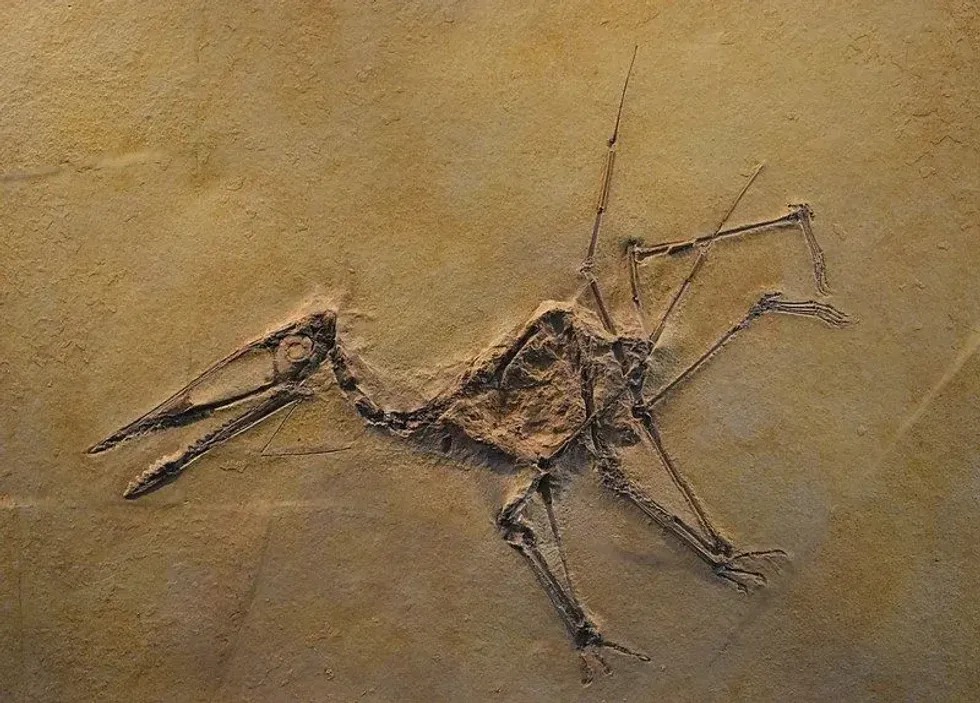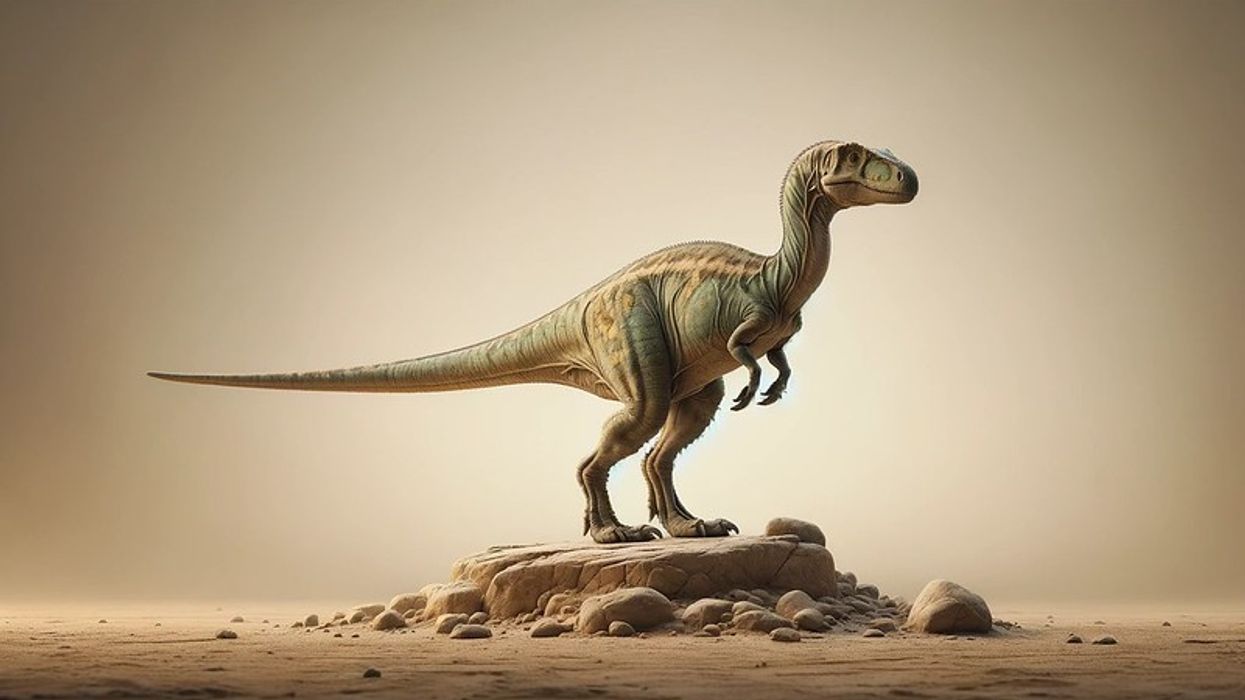Germanodactylus (meaning German finger) is a genus consisting of extinct Germanodactylid pterodactyloid pterosaur. It was named in 1964 by Yang Zhongjian. It had two species, G. cristatus and G. rhamphastinus.
These species are also called Pterodactylus cristatus and Ornithocephalus rhamphastinus. In 2017, G. rhamphastinus, was assigned its own genus which is called Altmuehlopterus.
It belongs to the order Pterosauria, suborder Pterodactyloidea, and the family Germanodactylidae. Several specimens of this genus were found in the United Kingdom and Germany. It has been estimated by paleontologists that the Germanodactylus existed from the Kimmeridgian to Tithonian of the Jurassic period.
It was a piscivore that is believed to have specialized in consuming shellfish. It is believed to have lived on the Solnhofen Basin's scrubby islands.
It was a medium-sized pterosaur that had a wingspan of 3.2 ft (0.98 m). The head crest of this pterosaur is its characteristic feature. The head crest is known to have had a bony growth that arose from its skull's roof.
S. Cristopher Bennet realized in 2002 that this bony growth was a base for a large, soft tissue-made crest. The crest could have been made of keratin.
Surprisingly, the crest of this pterosaur changed its color actively as a part of a courtship display during the breeding season! Had fun reading these roar-some facts? We suggest you keep reading to discover interesting facts about the Germanodactylus' pronunciation, time period, extinction, appearance, and more!
If you enjoyed reading our fun Germanodactylus facts, you must check out our Melanorosaurus and Lusotitan interesting facts as well!
Germanodactylus Interesting Facts
How do you pronounce 'Germanodactylus '?
Germanodactylus can be pronounced as 'jer-man-oh-dack-til-us'.
What type of dinosaur was a Germanodactylus?
It is a genus consisting of an extinct Germanodactylid pterodactyloid pterosaur (flying reptile), G. cristatus. G. rhamphastinus is a former species of this genus that was assigned its own genus called Altmuehlopterus in 2017.
It was a pterosaur and not a dinosaur. It co-existed with dinosaurs, however. The specimen of this genus was initially labeled as a specimen of Pterodactylus in 1901 by Plieninger.
Pterodactylus was a wastebasket-taxon to which dinosaurs that couldn't be assigned anywhere were placed. The specific name of the type species 'G. cristatus' was kept in 1925 by Carl Wiman and is a Latin term that translates to crested.
However, it was four decades later, in 1964 that a paleontologist called Yang Zhongjian felt that this species must be assigned its own genus. The name of the genus translates to 'German finger', honoring the location where it was excavated from.
In which geological period did the Germanodactylus roam the Earth?
It has been estimated by paleontologists that this pterosaur existed between the Kimmeridgian to Tithonian of the Jurassic period.
When did the Germanodactylus become extinct?
This flying pterosaur is believed to have gone extinct after the Tithonian age of the Jurassic period., approximately 145 million years ago!
Where did a Germanodactylus live?
It is believed that this pterosaur lived in Europe mainly as its specimens have been discovered from the United Kingdom and two specimens of juveniles of pterosaur Germanodactylus cristatus have been excavated from the Solnhofen Limestone in southern Germany. It is believed to have been endemic to Europe.
Dinosaurs such as Hungarosaurus, Eustreptospondylus, and Dacentrurus are also known to have dwelled in Europe.
What was a Germanodactylus's habitat?
It is believed to have lived on scrubby islands near water. As it was a piscivore, this type of habitat fulfilled its dietary requirements efficiently. We also know that pterosaurs were excellent tree climbers and might have dwelled in trees.
Who did a Germanodactylus live with?
It is not known who these pterosaurs lived with. However, we do know that they co-existed with Ankylosaurs, Europasaurus, and Allosaurus during the Jurassic period.
How long did a Germanodactylus live?
The lifespan of these pterosaurs has not yet been evaluated by researchers.
How did they reproduce?
These animals of the Jurassic period are believed to have reproduced by laying eggs. It is also assumed that they performed elaborate courtship rituals before breeding that involved their distinctive head crest made up of soft tissue.
The head crest of these pterosaurs is known to have had a bony growth on the roof of its skull and is believed to have been a base for a larger crest.
It is believed that the crest could change its color to a vivid color actively when it was the mating season of these pterosaurs. This was possible as the crest was made up of soft tissue.
Germanodactylus Fun Facts
What did a Germanodactylus look like?
 We've been unable to source an image of Germanodactylus and have used an image of a Pterosaur instead. If you are able to provide us with a royalty-free image of Germanodactylus, we would be happy to credit you. Please contact us at hello@kidadl.com
We've been unable to source an image of Germanodactylus and have used an image of a Pterosaur instead. If you are able to provide us with a royalty-free image of Germanodactylus, we would be happy to credit you. Please contact us at hello@kidadl.com Germanodactylus is a genus consisting of a Germanodactylid pterodactyloid pterosaur (flying reptile), G. cristatus. The G. cristatus is estimated to have had a wingspan of 3.2 ft (0.98 m).
It is also believed to have weighed as much as a present-day raven, which weighs between the range of 1.3-4.4 lb (0.69 – 2 kg). The Germanodactylus skull has been estimated to be 5.1 in (13 cm) long.
The former species G. rhamphastinus was slightly larger and had a wingspan of 3.5 ft (1 .08 m) and a skull measuring about 8.3 in (21 cm). The head crest of this pterosaur is its characteristic feature.
The head crest is known to have had a bony growth. This Germanodactylus bone wall arose from its skull's roof.
S. Cristopher Bennet realized in 2002 that this bony growth was a base for a large, soft tissue crest. The crest could have been made of keratin.
How many bones did a Germanodactylus have?
Many specimens of this genus have been discovered in the United Kingdom as well as two specimens of juveniles of pterosaur Germanodactylus cristatus have been excavated from the Solnhofen Limestone of southern Germany. However, the total number of bones is not yet available.
How did they communicate?
It is believed that these pterosaurs communicated through visual displays during the breeding season. The soft tissue crest could change its color to a more vivid one.
How big was a Germanodactylus?
From all the specimens discovered, the Germanodactylus' wingspan is estimated to have been 3.2 ft (0.98 m), with a 5.1 in (13 cm) long skull. The wingspan of this pterosaur is similar to the length of the Pisanosaurus!
How fast could a Germanodactylus move?
It was a fast-flying reptile that was skilled in catching fish from water bodies. However, the exact speed is not yet known. We do know that the Quetzalcoatlus northropi, the largest known pterosaur, could attain a lightning speed of 67 mph (108 kph)!
How much did a Germanodactylus weigh?
The weight of these pterosaurs is not yet evaluated due to a lack of research. However, it has been estimated that these flying reptiles were the size of a present-day raven! A raven of present times weighs between the range of 1.3-4.4 lb (0.69-2 kg).
What were the male and female names of the species?
There are no sex-specific names for the males and females of this genus.
What would you call a baby Germanodactylus?
The baby of species of this genus can be referred to as a hatchling or juvenile.
What did they eat?
It was a piscivore and is considered to have specialized in feeding upon shellfish.
How aggressive were they?
These animals are assumed to be not as aggressive and powerful as other large theropods they co-existed with. These flying reptiles had a small size and fed only upon seafood.
Did you know...
It has been estimated that pterosaurs first appeared 215 million years ago in the Triassic period and continued to live for 150 million years up to the Cretaceous period!
What do you mean by Germanodactylus?
Germanodactylus means German finger! It was named so in 1964 by Yang Zhongjian.
Did Germanodactylus eat fish?
Yes, Germanodactylus was a piscivore and fed upon sea animals like shellfish!
Here at Kidadl, we have carefully created lots of interesting family-friendly dinosaur facts for everyone to discover! Learn more about some other creatures from our Archaeoceratops facts and Pegomastax fun facts for kids.
You can even occupy yourself at home by coloring in one of our free printable Germanodactylus coloring pages.
The main image is owned by Tylwyth Eldar.










